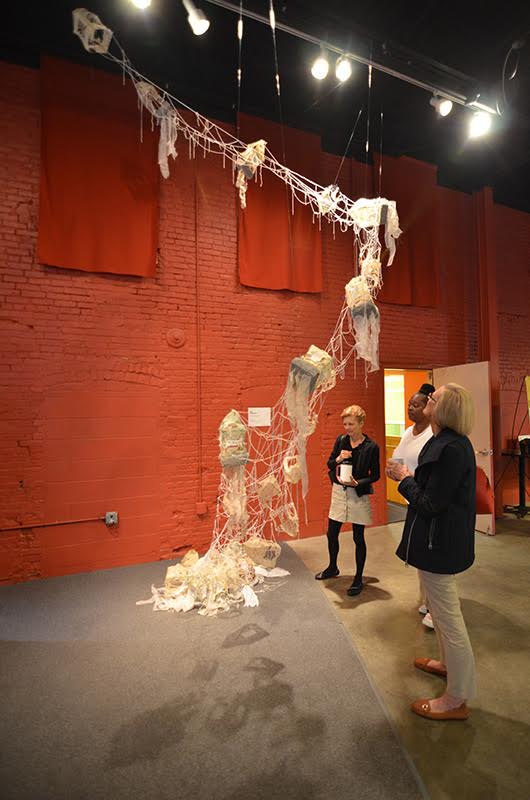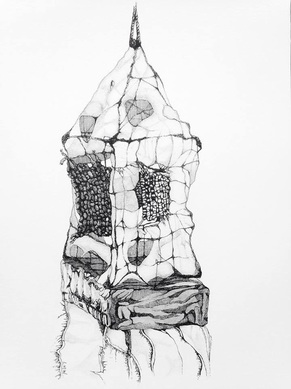That said, it is not only the discussion that happens with the jurors that is interesting, but also the discussion happening between the artists about their own art and each other's, and the public discussion. Issues are brought up about the technical aspects such as voting through a new phone app. Questions swirl around the jurors...why did they choose the artists they did for the short list? How did the jurors see all of the art in time to make informed decisions? How does the jurors' list influence the public? Why is the jurors' list released early if it is not supposed to influence the public? Why are some artists/venues given attention while other's are not? Is any of it "fair?"
Obviously tensions are high because there is such a large prize involved. Tempers are elevated, and it's unfortunate because when that happens we lose sight of why ArtPrize exists...which is for 2 reasons... #1. To put Grand Rapids on the map, make it a desirable place to live/work, attract business and therefore money, money that if used correctly will improve the lives of the city's inhabitants by way of schools, transportation, general infrastructure etc. and the contest creates a sense of pride (this ought to be the goal of all our US cities by the way, and is hardly a bad thing in the least). 2. To create a conversation about art. What is "good" art? What is "bad" art? Is it even possible to decide? As an artist I can say unequivocally YES! YES there is "good" art and there is "bad" art. The way I can determine which is which is by taking my opinion out of it while looking at it. So, I would like to try to dissect this contest a bit more because this is such a foreign concept to so many. One question that I saw on a message board was: "How can the jurors possibly see all of the art in such a short period of time and be able to make an intelligent decision?" Yes it is possible. Yes the jurors can have assistants look at the art and vet it ahead of time to whittle down the entries. They have a list of criteria that must be met in order for the work to be considered. Maybe the artist doesn't know. Maybe the juror himself doesn't know. But there is an intuitive "knowing" that comes from dissecting work day in and day out. Does the artist have a message? If so, are they expressing it intelligently in their artist statement? Does their work accurately represent what they are saying in their artist statement? Do the two match? An artist can be eliminated by their artist statement alone without the juror even having to see the piece. Why? Because so many statements are bullshit and when you are used to reading them, you can smell it immediately. That is just the statement alone. Including cliches is a quick way to have your artist statement tossed into the trash can. If the statement points to a strong concept, then the juror looks at the work. I don't know if this is what they did in the case of ArtPrize, but I can assure you in the numerous grants I've applied for, I've found the artist statement can rule you in or out at lightening speed. There is one grant application I just submitted that ONLY asked for my artist statement and project proposal. When they review this, THEN they will ask for my visual portfolio. Should one get far enough in any competition to have your work seen, it better match your statement. If your statement is overcompensating for your work, you will be eliminated. If it makes no sense in relation to your work, you will be eliminated. As an artist, it is your responsibility to ask yourself during the creation process, "what do I want the viewer to walk away with?" If you can't answer it yourself, the juror won't be able to find the answer either. If the message you are sending is received by the viewer-juror-public, then consider it a success. The jurors are critics that know history, trends, movements and relevance in art. They do not look at it through the filter of what will sell or what would look good over a mantle. And they have seen plenty of artists that have technical skill...this won't impress them either if the artist's statement/concept isn't strong. On the opposite end of the spectrum in the case of ArtPrize is the public/popular vote. I think the entire competition is brilliant for the very purpose of this aspect. Having previously been an artist concerned with "selling lots of art" to evolving into an artist concerned with "creating thought provoking art" I can't help but see both sides of the argument here. The public, for the most part, walk into this competition with an opinion of what art "IS." What is pretty. What means something to them. What touches them. As a result the art runs the gamut of good and bad. And the voters will vote on good and bad. Many of the votes are cast for beautiful cliches. Or for artists with great technical skill in drawing or painting. Votes are cast for artists that are masters at mimicking nature. Or artists that create ego-centric work that can never really speak outside of the canvas to the viewer. All of us are creating self-portraits in a sense...how literal that becomes is up to the artist. How much the viewer connects is up to the viewer. But the artists who get it "right" are the ones who can use their self-portraiture (likes, dislikes, passions etc.) to touch the viewer in such away that the viewer walks away with a little bit more knowledge and understanding than what they had before seeing the piece. Then there is the whole foot-traffic aspect of the competition and the reality that the more traffic that passes in front of your work, the better the likelihood you will garner votes. There are great artists hiding in venues all over the city of Grand Rapids...but if the viewers don't make it to that particular venue the artist doesn't get viewed and doesn't gather votes. It makes no difference if my venue has 8,000 visitors walk through the door and I receive 8,000 votes on my installation when the venue closest to the hotels and restaurants will get 20,000 people walking through their doors and another installation artist is displayed there. Discussion was brought up about whether releasing the jurors' short list was influencing the popular vote. I honestly don't think it does. There is a little cross-over between what the public and what the jurors like. But the people who did cross-over deserved to. They created something that was aesthetically (popularly pleasing) and conceptually (critically pleasing) successful. My hat's off to them, and I would have voted for the ones that crossed-over to both categories as well! That said, do I think I will win anything this Friday? I have no idea. What I do know is that I am learning a lot about myself in this process. I am learning a lot about the kind of artist I currently am, and the kind of artist I aspire to be. I know my audience and I connected with them successfully. I will win some. I will lose FAR more. But I will always keep trying. For all the rejection letters I receive regularly, it makes the acceptances and prizes all that much sweeter. I cherish them greatly and use them to push my career forward. This happens in such an organic way that I can't possibly be angry, sad or disappointed if I lose. In this sense, I feel like I've already won. No matter what, another door is already open and waiting for me to walk through.
0 Comments
The further along I trudged my artistic path, the more envious I became of the artists coming right out of college who knew themselves. I wanted so badly to be able to break free from my pre-conceived notions of what art was "supposed" to look like. Returning to grad school for my master's was a challenge. Not only was I one of the older students in the program, but I had been taught by my parents, media, society, etc. that I was supposed to make art that was "pretty." And in doing so it would sell. Because selling was the ultimate measure of success.
I was relieved to learn that is not the case. But breaking free of old habits is torture. It wasn't until I went to the Halle St. Pierre last summer in Paris and stumbled upon Paul Toupet that I realized what I want to be when I grow up. I am no longer concerned with "pretty." Just as it has taken me years to accept myself as I am, it has taken even longer to accept my art as it is. But really, they are one in the same. I can't separate myself from my art, and I no longer feel like I have to. It is an evolution that is exciting and scary, but nevertheless, necessary. I don't know if I will sell out shows like I did before grad school. I don't know if I'll be doing commissioned paintings anymore. I don't know if my work will be considered "pretty" anymore, but I know there is a place for it. It has taken me thirty-eight years to gain self-acceptance as an artist. It isn't as early as I would have liked, but had I not returned to school it might never have happened. Had I not divorced and been shoved out of my comfort zone, I never would have returned to school. I am the happiest I've been in a long time and welcome this next chapter no matter what it looks like! |
AuthorLisa M. Williamson is an artist living in Memphis, TN. CategoriesArchivesCategories |


 RSS Feed
RSS Feed